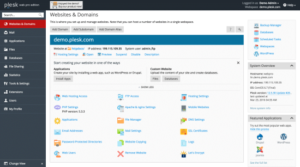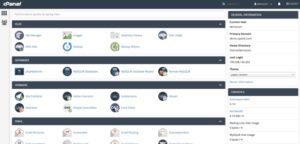When choosing between web hosting control panels, cPanel and Plesk are the primary contenders. Between them, they dominate the market for users looking for account and server management tools.
Released in 1996, cPanel is the original contender, and as such has a high number of legacy users. The current release is cPanel 66. Modern versions of cPanel are actually a combination of cPanel and WHM (Web Host Manager) interfaces, where the former is for customer account management, and the latter is for server administration. But, for the rest of this blog we’ll just call the package ‘cPanel’.
Plesk has been around since 2001, with the current stable release being Plesk Onyx.
cPanel vs Pleak: User interfaces
Of the two web hosting control panels, Plesk is widely considered to have a cleaner graphical user interface (GUI), and is a bit easier to use. The Plesk interface is more streamlined and has features grouped in a list down the left-hand side. When clicked these expand to show further options.

The cPanel interface, however, does not group the features and tools as helpfully, and is often seen as being more cluttered. cPanel does allow for customisation of the home screen to make it a bit easier to find things as well.

CLI (command line interface) access is available for both, should the user prefer it to a GUI.
cPanel vs Plesk: Performance
Generally, cPanel loads faster than Plesk. cPanel is the web hosting control panel that has really focused on optimising the performance. By focusing on reducing the amount of memory required, cPanel developers were able to speed up the page-load times within the panel, as well achieve faster times for account creation and other server management tasks.
cPanel vs Plesk: Features and tools
Out of the box, Plesk and cPanel both provide users with the same primary features for server and account management. Both can be used to configure DNS settings, manage email accounts, run FTP (File Transfer Protocol) and manage databases. Although it is possible to add extra apps to cPanel, Plesk comes with support for more useful apps and extensions straight from the box.
Plesk has support for Docker on Linux, with a catalogue of over 200,000 Docker images that can be launched from within the Plesk web hosting control panel. Plesk is also compatible with Git through the Gitman extension. There are workarounds to get Docker and Git running with cPanel, but they’re much more complex than with Plesk.
cPanel vs Plesk: Security
Both Plesk and cPanel are heavily focused on security. Although the features are different, Plesk and cPanel both come with numerous security tools.
cPanel security tools include: Automatic SSL certificate installation, password-protected directories and IP address denials.Plesk security features include: fail2ban intrusion prevention, inbound and outbound email antispam and active directory integration.
Plesk vs cPanel: Distros
One major difference between the Plesk and cPanel web hosting control panels is that Plesk is available on both Windows Server and Linux distributions, whereas cPanel is only available on Linux operating systems (although some backdoor methods are available to run cPanel on Windows servers).
The Linux distributions that support cPanel are CentOS, CloudLinux and RedHat Enterprise Linux operating systems. On the other hand, Plesk is available on 14 Linux distributions including CentOS, Ubuntu and Debian, as well as being available on Windows servers.
Which web hosting control panel you choose will often depend on which operating system you’re running on your server.
cPanel vs Pleak: Cost
Plesk and cPanel are licensed web hosting control panels, and are available on both shared servers and dedicated servers from Red Foot Hosting.
cPanel Web Hosting starts at $2.49 per month.
Plesk Web Hosting starts at $7.99 per month.
Choosing between cPanel and Plesk
Your decision could be based on which web hosting control panel is available to your operating system, but most likely it will come down to which panel you find easier to use. Whichever control panel you choose, they are both available on dedicated servers and shared servers from Red Foot Hosting.

